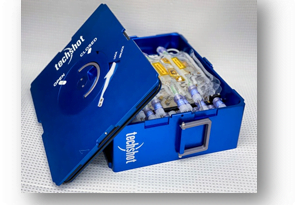INS TABAR VISITS ALEXANDRIA, EGYPT
Context:
Indian Navy’s frontline frigate, INS Tabar arrived at Alexandria on 27 Jun 21 for two days as part of a goodwill visit. India and Egypt share warm bilateral relations and ships of the Indian Navy have frequently visited Alexandria port.
About INS TABAR:
- INS Tabar (battle axe) is the third of the Talwar-class frigate of the Indian Navy.
- The frigate was commissioned on 19 April 2004 in Kaliningrad, Russia with Captain (later Vice Admiral) Biswajit Dasgupta.
- INS Tabar, a vessel in the Talwar class to be armed with supersonic BrahMos anti-ship cruise missiles.
- It is also equipped with Barak 1 missiles.
- INS Tabar is assigned to Indian Navy’s Western Naval Command, head-quartered in Mumbai.
- INS Tabar is a well-equipped warship that has the ability to handle air/surface/sub-surface missions or defending herself operating either independently on maritime missions or supporting a larger naval task force.
Contents
Other Frigates commission in Indian Navy
Shivalik class
- The Shivalik class, or Project 17 class, is a class of multi-role frigates in service with the Indian Navy.
- They are the first stealth warships built in India.
- A total of three ships were built between 2000 and 2010, and all three were in commission by 2012.
- All ships of the class were built by Mazagon Dock Limited.
- The class and the ships are named after hill ranges in India.
- Originally conceived as a successor to the Talwar-class frigates, the Shivalik-class frigates feature improved stealth features and land-attack capabilities.
Talwar class
- The Talwar class, also known as Project 1135.6, is a class of guided-missile frigates designed and built by Russia for the Indian Navy, as modified Krivak III-class frigates(the class that is also the basis of the Russian Admiral Grigorovich-class frigate), with a number of systems of Indian design and manufacture, including anti-submarine sensors (sonar) and communications equipment.
- Each ship of this class has a displacement of 4,000 tons and speed of 30 knots (56 km/h; 35 mph) and is capable of accomplishing a wide variety of missions, primarily finding and eliminating enemy submarines and large surface ships.
- Due to the use of stealth technologies and a special hull design, the frigate operates with reduced radar cross section (RCS), as well as reduced electromagnetic, acoustic, and infrared signatures.
Brahmaputra class
- The Brahmaputra-class frigates (Type 16A or Project 16A) are guided-missile frigates of the Indian Navy, designed and built in India.
- They are an enhancement of the Godavari class, with the same displacement, 3850 tons, and length, 126 metres (413 ft), but with different configuration, armaments, and capabilities.
- Three ships of this class serve in the Indian Navy.
- The class and the ships, are named for Indian rivers
Godavari class
- The Godavari-class frigates (formerly Type 16 or Project 16 frigates) are guided-missile frigates of the Indian Navy.
- The Godavari class was the first significant indigenous warship design-and-development initiative of the Indian Navy.
- The design is a modification of the Nilgiri class, with larger hull and updated armaments, as well as with a focus on an indigenous content of 72%.
- The class and the ships, take their names from Indian rivers.
- INS Gomati was the first Indian Navy vessel to employ digital electronics in her combat data system.
- The ships combine Indian, Russian, and Western weapons systems
INS TABAR Case
Following the media attention to the MT Stolt Valor incident, and a host of other pirate attacks on Indian vessels, as well as the general lawlessness around the Horn of Africa, the Indian government deployed INS Tabar to the area to conduct anti-piracy surveillance and patrol operations. She arrived to patrol the Gulf of Aden on 2 November 2008.
On 11 November 2008, INS Tabar was called into action to fight off a pirate attack on an Indian ship, the 38,265-tonne bulk carrier owned by the Mumbai-based Great Eastern Shipping Company Jag Arnav, and a Saudi-registered vessel, MV Timaha. Both ships had crossed the Suez Canal when they were attacked by pirates who surrounded the vessel in small boats. An Indian navy spokesman said there were no casualties in the operation. “Both the ships had crossed the Suez Canal and were a short distance away from Aden when the Saudi vessel was attacked by these boats, each carrying up to five pirates each. Our frigate patrolling the area responded to a distress call by “MV Timaha” and sent an attack helicopter carrying commandos which opened fire while the pirates were making repeated attempts to board the Saudi ship. While all this was on, the Indian cargo ship was attacked within the next 30 minutes. As Jag Arnav was about 25 nmi (46 km) away it gave a distress call. A Chetak helicopter, carrying a team of MARCOS (Indian Navy Marine Commandos) personnel, was sent to the location of MV Jag Arnav. After the ensuing battle, the team successfully thwarted the hijack attempt. The incident took place 60 nmi (110 km) from the coast of Somalia. From 2 to 19 November, Indian naval operations in the area, led by INS Tabar, successfully escorted approximately 35 ships, including many non-Indian flagged vessels, safely during their transit through these pirate-infested waters.
Just over a week after the MV Jav Arnav incident, on 19 November 2008, the Indian Navy reported that INS Tabar had come under attack from pirates. The crew of INS Tabar requested that the pirate vessel stop to allow a search, but the pirates responded with a threat to sink Tabar if it came any closer. The pirates then opened fire on Tabar before the Indian navy responded by returning fire. After the retaliatory strike, it was reported that a large explosion occurred on the pirate vessel, rumoured to have been caused by the pirates’ weapons cache. The attack continued for about three to four more hours, and resulted in the sinking of the pirate’s “mother-ship” (originally a Thai fishing trawler, FV Ekawat Nava 5). INS Tabar also forced the abandonment of another pirate vessel, while several pirates managed to escape via a speedboat under the cover of darkness. Recalling the incident to media persons, an Indian naval spokesman, Commander Nirad Sinha, said that “INS Tabar encountered a pirate vessel south west of Oman with two speedboats in tow. This vessel was similar in description to the ‘mother vessel’ mentioned in various piracy bulletins. INS Tabar closed in on the vessel and asked her to stop for investigation. Pirates were seen roaming on the upper deck of the vessel with guns and rocket propelled grenade launchers. The vessel continued threatening calls and subsequently fired upon INS Tabar.
Source: PIB
Discover more from Simplified UPSC
Subscribe to get the latest posts sent to your email.



